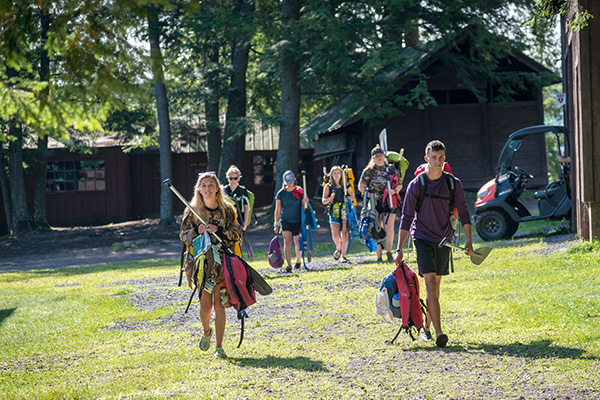
08/05/2025
As people’s interest grows in the history, culture and economic clout of New York’s Adirondack Mountains, a new mini documentary created to satisfy that curiosity has a tie to SUNY Cortland’s Huntington Memorial Camp on Raquette Lake.
Creation of “Camp Huntington: Preserving the Past, Building the Future” began when Peggy Lynn, a folk songwriter and performer, interviewed Rhonda Pitoniak ’01, M ’16, director of the William H. Parks Family Center for Environmental and Outdoor Education, in February.
Pitoniak was interviewed on June 11 for the video project for the mini documentary, along with several local people.
The documentary showed Pitoniak discussing Camp Huntington’s history, the early Adirondack Great Camp history, and traditions of camp life including occasional building invasions by wildlife such as one bear incursion. Meanwhile, film clips showed scenes of the early winter ritual of campers hauling their belongings across the frozen lake to the remote Camp Huntington.
The Camp Huntington segment, directed and filmed by Kevin and Emma Rogan and featuring music by noted folk musician Dan Duggan, was released July 29.
Lynn was researching for her planned book on Adirondack caretakers when she spoke with Pitoniak about the university’s Camp Huntington, named a National Historic Landmark in 2004, according to university history.
Owned by SUNY Cortland since 1949, the former Camp Pine Knot, considered to be the original great camp in the Adirondack style created by William West Durant, has educated many generations of SUNY Cortland students majoring in physical education, recreation, the sciences and other disciplines.
Pitoniak, who is as quick to lead a tour of the camp with Wall Street Journal editorial staff — which she did earlier in the summer — as to be the one pounding a sagging cottage door back into place or fixing a plumbing leak, described how this all came about.
“As (Lynn) interviewed others and spoke about the book, she was asked to help produce some segments for the Local Solutions in the Champlain-Adirondack Biosphere project in conjunction with the Folklife Center at the Crandall Public Library,” Pitoniak said.
The project was conceived by the Champlain-Adirondack Biosphere Network, a voluntary, internationally recognized partnership of individuals and organizations working to build harmonious relationships between people and the environment.
The Folklife Center and its partners had created this earlier segment filmed at nearby Camp Sagamore, providing an intimate look at the people who are working toward a sustainable future in the Champlain-Adirondack Biosphere.
These short films showcasing a diversity of voices on either side of Lake Champlain are meant to be freely used by the public.
Around the same time, when a Hamlets-to-Huts program group arrived at Camp Huntington for a tour led by Pitoniak, she had been informed that a Wall Street Journal reporter with a photographer would come along. The writer focused on the Hamlets-to-Huts program for an article that was published in the newspaper’s July 3 edition.